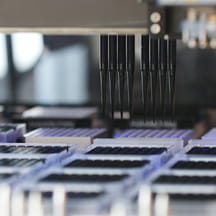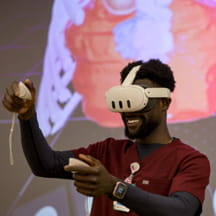Virtual and augmented reality
VR/AR software customized for pediatrics distracts patients and changes their perceptions of pain—improving outcomes and decreasing the need for pain medications. Gillette Children's Specialty Healthcare offers VR during interventions like infusion therapy. "It's a new field, but its use has been shown to reduce pain and anxiety when compared to the traditional standards of care, and we've seen those results," says Chantel Barney, Ph.D., clinical scientist. Interactive training and enhanced surgical planning programs are also possible, or being developed now, using VR/AR technology. "It's exhibiting potential to change the way we teach and practice medicine," says David Axelrod, M.D., pediatric cardiologist and co-creator of the Stanford Virtual Heart. "Once the infrastructure grows and the hardware is more available, it will change our field."
Organ donor compatibility
Traditionally, when clinicians assess the compatibility of a donor heart to a recipient, they use weight- and height-based parameters. But this method can eliminate viable donors, making it harder to find a match. So, John Dykes, M.D., clinical assistant professor and pediatric cardiologist, and his team at Stanford Children's Health, are using an on-site 3D imaging lab to identify total cardiac volume—a more precise measurement that greatly broadens the potential donor pool. Dykes says the technology ultimately could be useful in matching donors for other organs, as well as sizing for pediatric ventricular assist devices—work that's already being pioneered at Cincinnati Children's Hospital Medical Center.
Fetal surgery
Advances in technology are making more complex fetal surgeries possible—and successful. Doctors at Children's Minnesota last year successfully performed a fetal surgery on a fetal pericardial teratoma, a tumor on the heart of the fetus. An incision in the mother's uterus allowed surgeons to remove nearly 90 percent of the tumor. Doctors have completed the procedure only a few times before, and it was the first at Children's Minnesota. Advances in fetal medicine will continue to enable successful treatment for congenital diseases and other high-risk conditions, "allowing for cures to devastating diseases before a baby is born," says Brad Feltis, M.D., surgical director of the Midwest Fetal Care Center at Children's Minnesota.
NICU MRI
Innovation in MRI hardware is "one of the biggest game changers for MRI technology impacting pediatrics," says Shreyas Vasanawala, Ph.D., M.D., pediatric radiologist, director of MRI at Stanford Children's Health. Lightweight and flexible receiver coils are enabling clinicians to obtain higher-quality images more comfortably for small patients. Vasanawala says scientists are developing flexible coils that can be printed on fabric, so a child could wear a T-shirt embedded with coils. Meanwhile, Cincinnati Children's Hospital Medical Center says its infant-sized MRI scanner is the world's first designed specifically for infants and housed within a NICU. Providers can capture high-level imaging, which provides the best detail of the body, without the risk of leaving the NICU.
Smart pills
Children's Health in Dallas is the first pediatric system in the United States to use digital medicines to help transplant patients stay on top of the medications essential to the survival of their new organs. The medication includes a tiny sensor that, when ingested, transmits a message to the patient and doctors—and parents, if applicable—to confirm the medication was taken. "This is part of the future of medicine," says Dev Desai, M.D., chief of pediatric transplantation at Children's Medical Center in Dallas. "It's a benefit for the patients; it's a benefit for the care providers and, in the long run, it will have overall public health benefits as well."
Alternative to treat allergic reactions
Pediatric allergist Leigh Ann Kerns, M.D., at Cleveland Clinic Children's, invented a next-generation epinephrine auto-injector device for severe allergic reactions. Designed specifically for children age 2 and under, MedEject delivers the appropriate dosage of medication in a less invasive manner than current auto-injectors—no stabbing required. The design is meant to be more user friendly for parents and non-health care professionals.
Family advocacy at the hospital
Pediatric patients and their families are increasingly involved in influencing public policy that dictates the course of health care in the United States. Rather than sending patient families and hospital representatives to Washington, D.C., to meet their representatives, Blank Children's Hospital in Des Moines, Iowa, took a new approach by hosting its own Family Advocacy Day. The hospital invited elected officials to spend the day at the hospital meeting with families and holding constituent meetings. "It was a great opportunity to expose other parents to this type of event," says Jaci Strube, who serves on the Family Advisory Council at Blank Children's. "It also exposed our lawmakers to people they might not get to meet out in D.C."
Social determinants of health
Children's Minnesota is among a growing number of hospitals using technology to meet the needs of patients based on social determinants of health. Using software called NowPow, Children's Minnesota staff refers patients and families to resources filtered on personalized criteria including condition(s), address, gender and preferred language. Closed-loop functionality will enable the hospital to coordinate with community resources to encourage patient follow-through. Early testing is promising: with the help of the technology, Children's Minnesota has seen follow-through with internal resources increase from 40 percent to 80 percent.
Patient transportation
It's the reason 3.6 million patients each year miss at least one medical appointment. "When you look at no-show rates, transportation represents a real barrier," says John Brownstein, Ph.D., chief innovation officer at Boston Children's Hospital. "This is one of the important social determinants of access to health care." Brownstein co-founded Circulation, an on-demand ride-ordering service tailored to health care providers. Providers can book patient pickups or schedule rides home upon discharge, usually at a savings over traditional transportation solutions. Currently used by more than 100 health systems, Circulation says it has reduced no-shows by 68 percent while providing a ride cost savings of 70 percent to medical facilities.
School-based health services
Hospitals are improving outcomes for children where they spend most of their days—schools:
- Children's Health in Dallas estimates it saved $1.8 million in diverted emergency department costs thanks to its school-based tele-behavioral health program.
- Akron Children's Hospital administered nearly 4,000 flu shots last year as a part of its school-based clinics, saving families $400,000 in costs and lost wages.
- Wolfson Children's Hospital in Jacksonville, Florida, is providing a true medical home. Roughly 94 percent of children in the city's northern and western neighborhoods don't have a primary care physician, so the hospital created a school-based health center model.
Night interruptions
There's no question that lack of sleep has adverse effects on children, especially those in the hospital. Yet, the overnight hospital routine is often disruptive to patient sleep. Children's Hospital of Richmond at VCU implemented a quality improvement project attempting to limit those disruptions. The frequency of routine vitals and lab draws were delayed—or eliminated altogether—for low-risk patients. None of the participating patients required a change in level of care and the overall patient outcome: increased ZZZZZs.
PICU Up!
Illness shouldn't mean stillness," is how Sapna Kudchadkar, M.D., describes Johns Hopkins Children's Center's PICU Up! Early Rehabilitation and Progressive Mobility Program. Kudchadkar designed the program with a simple goal: to reduce sedation and get critically ill children out of bed. The test period showed a 65 percent increase in mobility activities; sitting at the edge of the bed, standing, moving from bed to chair and playing with toys. Results show reduced patient trauma and improved recovery for children who maintain physical activity during a hospital stay.
Culinary medicine
Culinary medicine is the practice of using food to restore health, reduce side effects of treatments and improve long-term quality of life. The pediatric dietetic experts at Children's Hospital of Orange County have built a culinary medicine curriculum tailored specially for use in a pediatric hospital. And using a mobile kitchen called the Charlie Cart, the Child Life team at Memorial Health Dwaine and Cynthia Willett Children's Hospital in Savannah, Georgia, is testing the program to help children prepare healthy recipes and learn about the health benefits of different foods.
Couplet care
"The great thing about couplet care is that it keeps families together," says Christian Pettker, M.D., chief of obstetrics, Yale New Haven Children's Hospital (YNHCH). That's the driving idea behind couplet care, where mothers and their babies can remain together during their hospitalization. As one of only two NICUs in the country to offer couplet rooms, YNHCH aims to foster skin-to-skin contact and support breastfeeding. "There's an undeniable benefit of keeping mothers and babies together," Pettker says
T-cell immunotherapy
Using a patient's white blood cells, T-cell immunotherapy attacks certain cancer cells much like how the body's immune system would fight an infection. Seattle Children's Hospital is conducting several trials using the reprogrammed T-cells and is reporting remission rates of 93 percent for leukemia patients. Not only is it proving to be effective, but it also works faster and is easier on patients than traditional cancer treatments. "The child only needs one dose of therapy, and within two weeks, they're back at school and on the soccer fields instead of going through three years of chemotherapy," says Michael Jensen, M.D., director of the Ben Towne Center for Childhood Cancer Research at Seattle Children's. "It would represent a paradigm shift in how kids can be cured."
Artificial intelligence
Artificial intelligence (AI), the ability of algorithms and software to think and learn while analyzing mountains of complex medical data at light speed, is revolutionizing health care. AI is a force behind many of the innovations on this list, and its potential reach seems limitless. One profound effect of AI could be on underserved pediatric populations. Many AI tools today can analyze data just as well as—or in some cases, better than—human clinicians. The availability of technology that can, for example, accurately read an X-ray or detect a pediatric heart murmur, could help primary care physicians or community providers make informed decisions in areas where a radiologist or cardiologist isn't readily available.
Predictive analytics
The rapid advancement of predictive analytics technology is changing the way clinicians work. A prime example of predictive analytics in practice is at Children's Hospital of Orange County (CHOC). Looking to reduce readmission rates, CHOC data scientists studied roughly 38,000 patient discharges and applied sophisticated algorithms and hundreds of variables to the data. The resulting predictive tool provides care teams with readmission risk factors for patient discharges. "How we practice medicine is going to be dramatically enhanced by predictive analytics," says William Feaster, M.D., CHOC's chief health information officer. "This is going to take off and absolutely explode over the next five to 10 years."
Gene editing
There continues to be new developments around the rapidly shifting evolution of CRISPR, a gene-editing technique that allows scientists to cut DNA at specific locations in the genome and make targeted modifications to correct disease-causing mutations. Now, scientists are using a new variation called CRISPR-GO—think of it as "molecular tweezers" compared to the "molecular scissors" of CRISPR. Stanley Qi, Ph.D., assistant professor of bioengineering and of chemical and systems biology at Stanford University, says it moves the technology closer to true gene editing. "What I foresee as the most impactful in the near future is the use of our technology to control and enhance repair pathways after the cutting has been introduced," Qi says.
Whole genome sequencing
Researchers at Rady Children's Hospital San Diego are bringing whole genome sequencing (WGS) to mainstream use. Having a map of a person's unique DNA can help doctors pinpoint a diagnosis that might otherwise require treatment by trial and error. Until recently, the process was too costly and took too much time to have a meaningful effect on outcomes. But Stephen Kingsmore, M.D., Sc.D., president and CEO of Rady Children's Institute for Genomic Medicine, has perfected a method to speed up WGS diagnoses from weeks to hours. By diagnosing genetic disorders in time to change acute medical or surgical management, rapid WGS can improve outcomes and reduce inpatient costs.


